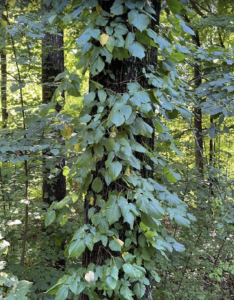Super-Human Poison Ivy Is On The Move. Why?
Posted on | September 19, 2023 | Comments Off on Super-Human Poison Ivy Is On The Move. Why?

Mike Magee
Connecticut loves its’ trees. And no town in Connecticut loves its’ trees more than West Hartford, CT. The town’s borders include an elaborate interconnected reservoir system that does double duty as a focal point for a wide range of nature paths for walkers, runners and cyclists.
While walking one path yesterday, I came across the tree above with a massive upward advancing vine. My “PictureThis” app took no time to identify the plant. To my surprise, it was Toxicodendron radicans, known commonly as Poison Ivy.
The description didn’t pull punches. It read, “In pop culture, poison ivy is a symbol of an obnoxious weed because, despite its unthreatening looks, it gives a highly unpleasant contact rash to the unfortunate person who touches it.”
Its’ pain and itch inducing chemical oil covers every inch of the plant, and is toxic to 80% of humans. It was discovered by Japanese chemist Rikō Majima in the lacquer tree and named urushiol (Japanese for lacquer) in 1922. It is a derivative of catechol, an organic compound with the molecular formula C₆H₆O₂.
But the giant vine this week was nothing like the creeping little three leaf plant most children have been taught to avoid. This was a giant – a very different aggressor worth investigating. Its leaves were impossibly large and its vine straight and thick, and its vitality unhampered by a need to support elaborate roots or bark.
Others have noticed it too including “Pesky Pete” who has made a good living removing the invader from properties in Massachusetts and southern New Hampshire. And recently business has been booming. This is because the plant, which up to this year has never appeared in the region before May 10th, suddenly appeared this year on April 23rd.
This was no surprise to Bill Schlesinger, resident of Maine and Durham, NC. Officially, he is “William H. Schlesinger … one of the nation’s leading ecologists and earth scientists …a member of the National Academy of Sciences, …has served as dean of the Nicholas School of the Environment at Duke…”
Turns out Bill was in the lead on a six year project termed the “Duke University Free-Air CO2 Enrichment Experiment” between 2000 and 2006 when the results were published. They had been following tree declines in the Duke Forest where predatory vines had played a major role. They decided to encircle and isolate six giant forest plots and pump them full of CO2, and then catalogue the effects.
Their 2006 publication revealed that:
- CO2 enrichment increased T. radicans photosynthesis by 77%
- Increased the efficiency of plant water usage by 51%
- Stimulated the growth of poison ivy during the five growing seasons ambient plants
- Annual growth increase of 149% in elevated CO2 compared to ambient plants.
- Notably larger than the 31% average increase in biomass observed for woody plants
Poison Ivy was the fastest grower of them all in the experimental CO2 forests. Bill’s collaborator, Jacqueline E. Mohan, carried the work further as head of the Harvard Forest project in Massachusetts. They reported out results, not only on CO2 soil, but also warmed soil. They heated the upper layer of soil by 9 degrees. Her response to the findings was surprisingly down-to-earth. She said, “My heavens to Betsy, it’s taking off. Poison ivy takes off more than any tree species, more than any shrub species.”
Mohan and coworkers made it clear at the time that this was not great news for 8 out of 10 Americans who are sensitive to poison ivy. Not only did global warming and carbon footprints accelerate growth in the plant by 70% in its leaf size and biomass, but additional experiments revealed that these environmental enablers increased the amount of urushiol in the plant
As Duke was building those first towers to isolate their experimental forests in 2000, the International Geosphere-Biosphere Program was holding its annual meeting in Mexico. A Working Group subsequently focused on defining planetary boundaries (PB) that would assure both planetary and human health.
Nine years later, the group published “A Safe Operating Space For Humanity” in Nature. In it they proposed nine “planetary boundaries” to gauge “the continued development of human societies and the maintenance of the Earth system(ES) in a resilient and accommodating state.” In their view, measuring and ongoing monitoring of these boundaries would provide “a science-based analysis of the risk of human perturbations” that might “destabilize the ES on a planetary scale.” The work was updated in 2015.
The first Planetary Boundary listed was Global Warming with two measures, atmospheric CO2 and air, water, and soil temperature. As for human perturbation, as the picture above well illustrates, you can add super-human poison ivy to the growing list of unintended consequences.
Tags: Bill Schlesinger > Duke University Free Air CO2 Enrichment Experiment > global warming > International Geosphere-Biosphere Program > Jacqueline Mohan > Pesky Pete > poison ivy > Rico Majima > Safe Operating Space for Humanity > Toxicodendron radicans


